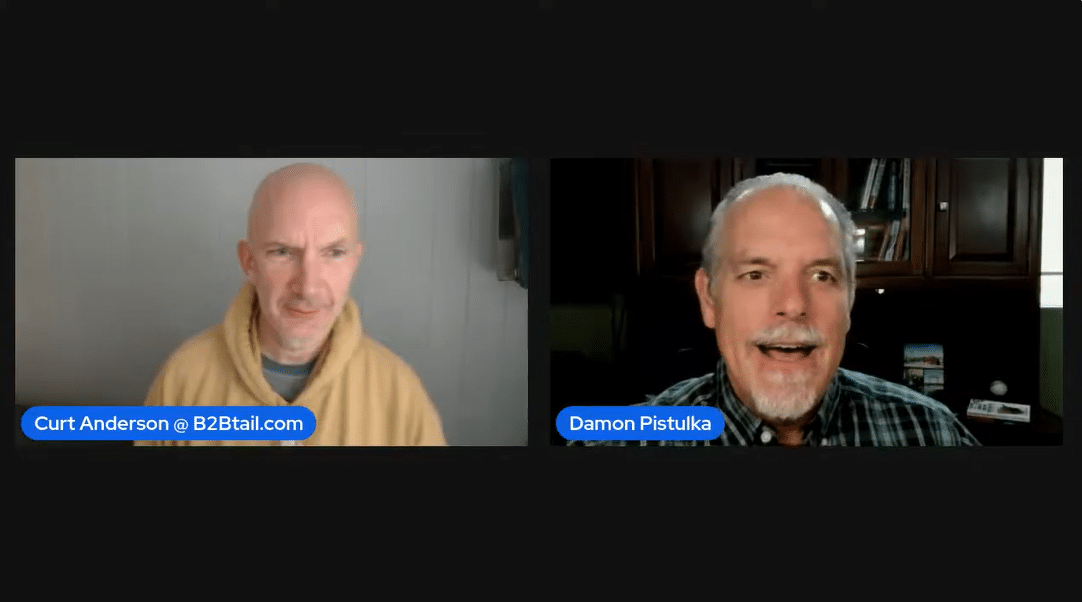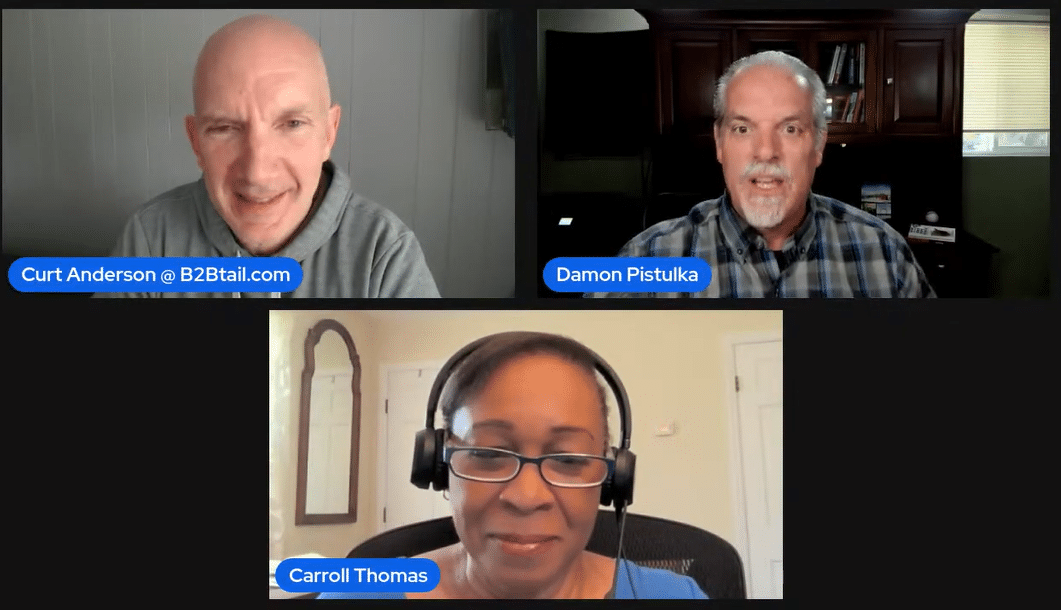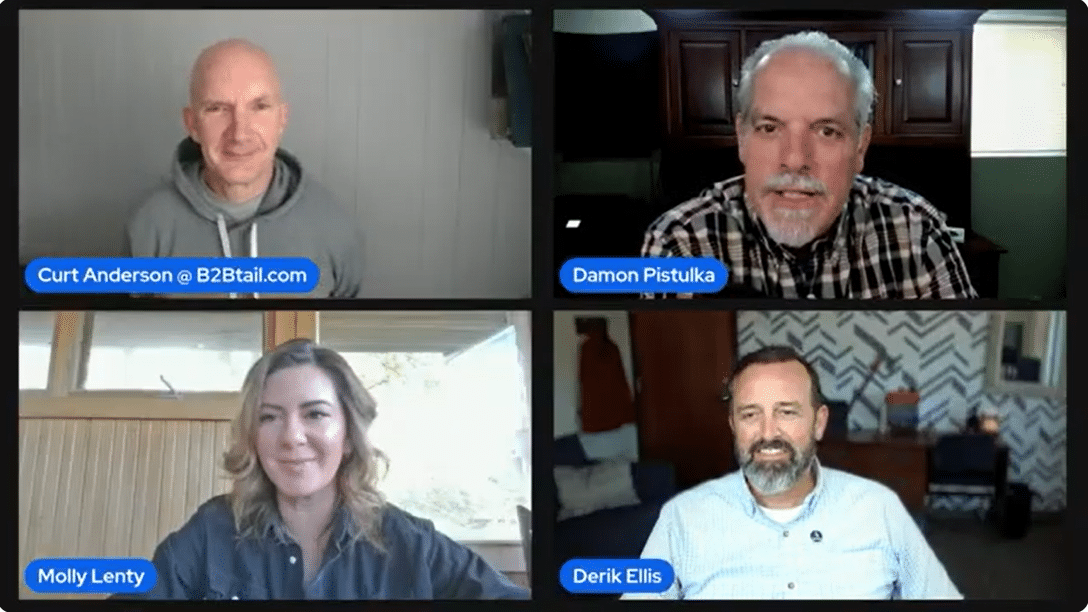• 28:35
SUMMARY KEYWORDS
digital game plan, strengths and opportunities, radical candor, niching down, core strengths, unique value proposition, speed to market, customer satisfaction, lead time reduction, competitive advantage, AI tools, marketing strategies, customer engagement, business focus, manufacturing efficiency
SPEAKERS
Curt Anderson, Damon Pistulka
Damon Pistulka 00:09
All right, everyone, it is Friday, and you know what that means. It’s time for manufacturing, e commerce, success. I’m one of your co host, Damon Pustulka, that pretty gentleman right over there, Curt Anderson and I, we’re going to be talking today about the digital game plan and why it’s important to be focusing on your strengths and opportunities. Curt, take it away. Damon, how are you dude?
Curt Anderson 00:37
Man, it’s been a little while, hasn’t it? I feel like, like, feel a little rusty, like we got to get back on the bike here. So, yeah, hey, Happy Friday to you. I know this is a bit of a pop up. We didn’t have this plan, and I’m looking like, there’s no there’s no guest down below, right? There’s no
Damon Pistulka 00:52
guests. There are no guests today. Just,
Curt Anderson 00:55
you’re stuck with me. Man, sorry, yeah, yeah, you’re like, my, my poor wife, like you’re stuck. For
Damon Pistulka 01:00
some reason, I just, and this is really a horrible analogy, but I feel like dodgeball, the two reporters on dodgeball on ESPN the Ocho, right? That’s, I don’t know why that came up in my mind, but that is a funny
Curt Anderson 01:16
movie. Yeah, Ben Stiller, yeah. Alright. So let’s dive in. Alright? So speak, speaking of dodgeball, was that a strength of yours as a kid? Like, were you a good dodgeball player?
Damon Pistulka 01:25
I as I got older, I was, yeah,
Curt Anderson 01:27
I bet, like, I wouldn’t mind to be on the other side of you. I bet you threw fastballs as I got older, I could, I can play. You could throw the ball. And I’ve eaten a few too. Yeah, I’ve eaten plenty, right? Take one right now. Take a header, right? Yeah. So, all right, let’s dive in. So we’re talking about the digital game plan, and we’ve got this fun little exercise we love, love, love doing with our clients. We call it the so versus the so what? So now, if somebody’s like, hey, what on earth is so Damon, like you, you’ve heard of the SWOT analysis, have you not you’re doing Yes, I have done one or two in your lifetime. Have you not couple? Yes. Okay, so we’re going to take the s, w, o, t, let’s, let’s, let’s get that W out of there. Man. Like, you know, when you talk about, like, I already know my you know, I got too many weaknesses, right? So let’s take the weaknesses out. We’re going to take the threats out. Let’s talk about the so what are we talking about?
02:19
The strengths and opportunities, the things we’re really, really good at, and the opportunities we see to grow our business, to take market share in an industry, or do something that somebody else isn’t doing now, or do it differently,
Curt Anderson 02:34
absolutely. So let’s dive in and so let’s talk about our strengths. So demo, what’s one of your strengths?
Damon Pistulka 02:43
Hmm, I’m a good reader. You’re
Curt Anderson 02:45
a good reader, you’re you’re, you know what? I’m reading, a great I’m reading, speaking of strengths and weaknesses, I’m reading the book by Reed Hastings, the founder of Netflix, on the culture that they built at Netflix to make Netflix what it is, right? Total startup from scratch, and it is a phenomenal book. And they’re constantly talking about their strengths, you know, one of their, course, the core strengths, the culture that he committed to the company to make Netflix what it is today, radical candor. Radical candor. Like, you know, don’t be no sugar coating. Yeah, we’re not, like, No, you know, it’s not like everybody gets a trophy. Like, I mean, like they play hardball. Yeah,
Damon Pistulka 03:25
I’ve got, I’ve got a long term client that that they practice that. And it is it you definitely get into some uncomfortable situations once in a while. But boy, when you do it with respect and and really understand that we’re all there, do the same thing, it’s a remarkable what you can do with that, right? I totally
Curt Anderson 03:43
agree. So alright, so we’re gonna, I’ve got a little worksheet that I’m gonna pull up before I go there, you know, I think, you know, there’s a little tagline our dear friend Wesleyan Whitaker always uses when you try to be everything to everybody, you become nothing to no one, right? So why is it just so critical to not be everything to everybody.
Damon Pistulka 04:03
Well, because, really, in what you do it, you can be a great say, I’m a great doctor, right? I’m a great doctor. Well, what can you what can you do? Why I’m a good doctor. I can treat people well. People are always going to ask, well, I’ve got it. I’ve got a problem with my hip. Is that really? Are you really good at hip problems? And I’m a doctor, sure I can do anything. No, you can’t, because there’s Steve down the road or Susan down the road. She’s a hip doctor. Susan knows hips really well, right? Susan, look at my hip, and in 30 seconds, tell me what’s wrong. You might have to go back to your books and figure it out. I mean, that’s just an example. What niching down and getting really focused in on your strengths are and and understanding that there are some things that we’re really good at, and if we lean in on those strengths, it can really help us. Yeah, I
Curt Anderson 04:56
agree with the doctor analogy. You know, you and I always enjoy. Using the the right knee guy, right? Yep. So you know, if you say, like, Hey, I’m a general practitioner, you know, like, you say, you know, a little bit of everything, I’m looking for a doctor to help me out with, like, hair or something, you know, but, you know, not working out. So good. Damon, so no, but the thing is, with the with the right knee guy, it’s like, when they laser focus and, like, that’s their specialty. That’s what they’re the best at. They work on your local professional sports team, you know, that type of thing. You know? It’s like, yeah. And so for us at whatever business you’re in, you know, we’re always speaking to manufacturers or consultants or marketing that type of thing. It’s like, you know, again, instead of being the CNC shop, that’s everything. Everybody bend metal, you know, cut steel, circuit boards, whatever it is that you make, instead of, like, hey, we do forever. Like, how about if we just kind of niche that down? How about the CNC example? Like, what would be a great example if we do CNC machining? Like, how could we kind of, like, tighten it a little
Damon Pistulka 05:54
bit? Well, I’ll tell you a company that I actually ran years ago. We, we were a five axis CNC machining company that specialize in hard metals like titanium and other crazy aerospace kind of stuff. Titanium is not nearly one of the craziest, for sure, but that’s that’s just a real simple way to do it, but you can get focused into the type of material, especially type of process, especially industry. I mean, you really can do this down into, I do five axis CNC machining of cobalt, right for the defense industry, right in low production runs, or in medium, you know, 100 to 1000 piece production runs, or something like that. You can get into those. That’s where niching down really helps you, because then when someone sees you, they’re not going to go, Hey, I got this aluminum part. Can you make that? You got a high speed aluminum mill sitting around there? No, right. We do right. Bump, bump, bump, bump, right. And a lot of people that we see, and we talk with a lot of a lot of contract manufacturers, they’re afraid to niche down like that, but also by not doing that and staying real broad and go, Okay, here’s our equipment list. This is the kind of processes we can do. You’re not giving someone enough information to make a decision. I think that’s the real benefit of niching down, is I give potential customers the information so that they can say, Oh, I’m not a customer for them because I got an aluminum part, or, Yes, I got a wicked material. I need five axis CNC machining. I’m in the the defense space. They know what we’re about. They know what ITAR is. They know what all this other stuff is that they need to know. Boom, they’re my per they’re they’re my soul mate, you know, supplier,
Curt Anderson 07:43
Right exactly. And kind of stepping away from clients where, like, maybe it’s not a great fit, you know, like, when you think about how many times or situations you take on a customer, take on a client, drains a lot of resources, you’re kind of going in directions that you don’t want to go. And, you know, I don’t know if I say, like, we’ve all done it, I’ll say, I definitely have done it. I don’t want to throw anybody else out there, you know, it’s, it’s like, you’re like, oh my goodness, you know, why did we get into this? You know, we had, we had a guest on the show one time, and we asked her, what was the best business advice she ever received? And she’s like, you know, what was it? The what’s your, what’s your pain in the butt dollar
Damon Pistulka 08:19
or something like that. What was it? Something like, about walking away? Dollar, is it walking away? Dollar,
Curt Anderson 08:24
we’re like, you know, what threshold do you hit? We’re like, Man, this just isn’t a great fit. And back to that right knee analogy, you know, like our buddy Max Krug, introduced that to us when he was like, I want to be so specialized that, like in that right knee Doctor analogy, if you hurt anything on your body. Man, I’m not the right person. I can’t help you. You hurt your left knee. I’m still not the right person. But, boy, if you’ve hurt your right knee, there’s not a person on the planet that is better at you know, in my in this example with Max, he’s like, there’s not a person better that can help the right knee than me. He’s like, I want to be the right knee guy. In my expertise. He’s a Theory of Constraints expert. And so that’s our message today. Is like, when you focus if you’re selling services, intellectual property, how can you be the absolute best if you’re selling widgets, products, you know, really having that tough, hard look, Diane buyer calls it, you know, looking in the mirror, right? How do you look at yourself in the mirror and say, like, I’m really not that great at this? Why are we doing it right? And
Damon Pistulka 09:22
it’s really hard for salespeople in the field, especially to to utilize that, because they’re like, Oh, God, we got this great new opportunity. And let’s go. Let’s go look at it. I understand that. And there are some times that you’re going to look at those opportunities, you’re going to say, this is a market we, you know, in stepping back and looking, oh, this is a market that we want to break into, and it might be the time to do it, but a lot of the times, those are things that you just have to say that’s really cool, but it’s not for us right now, you know, and you’re making a fantastic
Curt Anderson 09:51
point, because, you know, somebody could push back and say, Hey, wait a minute, you know, when do I take a chance to diversify? Or, you know, like I always say to my daughter. Like, you know, always try a new food. Never turn on a new food, because you never know what your next favorite dish is going to be until you try it, right? But if you try it and you don’t like it, at least now you can say, well, I don’t like it, but just say you don’t like it before you try it. So there is a balance between like, okay, hey, we’re going to try something new. But, you know, we have enough equipment, we have the experience, we have the expertise, or we brought a new person on a team that we feel comfortable and, you know, and justified, that we can take on this new service, yeah, this new solution. And let’s try it. So, alright, let’s, I’m going to share my screen. Damon, let’s take a look at the digital plan, what we’ve got going on here, and give me one second. How about here? How about here? And can you see my screen?
Damon Pistulka 10:40
Yep, it’s coming up. There we go. The so versus so what the so
Curt Anderson 10:44
versus the so what so? Damon, dive in a little bit. So we’re talking about the strengths and opportunities. Okay, so on our this is a digital game plan. We have this with all of our clients that we work with. It’s this great tool, man, I tell you, we have such a great time really diving in, getting a deep understanding. And a lot of times for clients have been in business for years, decades, we still have, like, Aha moments. We’re like, you know what? You know, we’ve always done this that way, or we’ve always thought that we were good at this, but now that we’re going through this exercise, maybe we’re really not as good as we thought.
Damon Pistulka 11:15
Yep, yeah, that’s for sure. And hey, I just want to say a couple things. First of all, we got Sadia stopping by to say hello, and she said the doctor example is really good. And then we got we actually have a doctor. Oh yeah, good job guys. Thank you. Thanks for stopping well. Hey,
Curt Anderson 11:32
happy Friday to everybody. Thank you for joining us again. Drop us note. Let us know that you’re out there. Let me connect with you guys. Connect with demon on LinkedIn. Love to connect with myself. My name is Curt Anderson. Love to connect with you guys. See what’s going on in your world. But let’s go back to the digital game plan. So David, you know. And when you do this exercise, nice thing, you know, it’s behind the scenes, you know, yeah, when you take a look here, you know, we call it the so versus the so what. And so, when we get to the strengths down here, you see this little section down here, and what we like, like, let’s call it the bride party. And what we encourage you to do is, like, you know, just kind of brain dump. And like, Don’t be modest. Don’t be humble. You know, you’ve got, you know, your God given talents, your expertise, machinery, equipment, as a doctor, whatever your service that you’re providing. And like, you know, get in there and, like, really go hardcore. Like, hey, this is what we’re best at. You know, what are your thoughts? David, yeah. I
Damon Pistulka 12:22
mean, this is where you really get into it. And you think about, where are the if I’m a job shop, what jobs have we done that? It’s just really worked out well for us and our customer, or our customers were just delighted because a it works so well inside of our facility. It works so well for them and and you, they really appreciated and valued the the work that you did, whether I’m, I’m making a truck, or I’m, I’m doing a component, a CNC or metal fabricated component or injection molded part. It doesn’t really matter what you’re doing, but those are the kind of things that you really want to understand. Is like, hey, when we do this kind of work or build this kind of product, our customers love it,
Curt Anderson 13:07
right, absolutely. So when you, when you really laser focus on your core strengths, again, if you’re just joining us, we’re, you know, we’re, we’re doing a little like we’ve, we’ve got our own version of the SWAT there. Damon, we took out the W, we took out the T. You know, you’re in a little happy place. You don’t have weaknesses, you don’t have any threats. Let’s throw those out the window. But when you really focus on exploiting your core strengths, you know, and we talk about, like, that unique value proposition, another great you know, we were talking about that book, if you’re looking for a book to read that wonderful book I mentioned by from Reed Hastings about Netflix, but you and I love preaching about the blue ocean. And the more that you can focus on your core strengths, on what you’re best at, that’s going to separate you from those weaknesses, from those threats. Damon, let’s talk about opportunities. Let’s dive into the Oh. How do you help? You know I have, I’m a horrible culprit of shiny object syndrome. Add whatever you want to call it. You know, let’s chase this one. Let’s chase this one. How do you recommend? How do you advise people? How do you suggest? How do we stay in our core with by pursuing opportunities. What do you have there? Well, I
Damon Pistulka 14:15
think first of all, you get them out on the table and you go, okay, what are the biggest opportunities in front of us right now where just do that, and then you have to go back through them again, and you look, okay, which of these opportunities do we have the most competition in? Right? Do we have 100 other people doing the same thing, right? Well, that might help you reduce the ones down and go, Okay, these we don’t have much competition, but these are still really good opportunities, and you start looking at them at different ways, and that’s really how you in my mind anyway. And when we’re working we that’s how we go through this process is to go, Okay, let’s get them all on the table, and let’s start refining which ones we want to focus on. We’ve got 100 and then we go, okay. Okay, these are really competitive, and we got some big companies, lots of money that are in these. Okay, we’re going to slide those off to the side. We may do that later. We’re not going to do that now. And we’re going to say, okay, and then these opportunities are in a completely new market that we don’t have that capacity. They’re really cool, really awesome, but we just don’t, we’re not in the right spot now. And then you go, okay, these are, these are lower competition, competition opportunities that we could execute on really well that align with our strengths. Those are the ones that we really prioritize and focus on, because that’s where we’ll get the biggest return on our our investment of our effort.
Curt Anderson 15:37
Yeah, I totally agree. And so one thing to think about for folks out there is, you know, first off again, you know, drop us a note. Let us know that you’re out there. Love to hear what you guys have going on. And hey, skyler’s here today. Happy Friday. Skyler,
Damon Pistulka 15:49
what’s happening?
Curt Anderson 15:52
You know, a lot of times, you know, so in the E commerce world, you know, what we love to preach is that 8020 rule, right? The 8020 rule. So let’s just say your company. And again, maybe, if you’re not in a product, you’re, you know, you might like, hey, this doesn’t resonate, but it could. I don’t care what your solution is, what your services, what you’re providing is, a lot of us have that 8020 rule, right? The 8020 rule is this, if you’ve not familiar iceberg effect, right? Is 80% of your sales, 80% of your profits, commonly, typically, in many businesses, will come from 20% of your customers, right? And so you know, or your product line, or whatever you know. So that’s your core strength, that’s what you’re best at. And like, hey, we want to diversify. We feel a little bit vulnerable. Maybe we have too few customers or too few products. But if you really laser focus on the 20 that’s driving your 80, and that’s what you’re best at, that’s your core strengths, those are opportunities to really exploit and take to the next level. What are your thoughts? Yes,
Damon Pistulka 16:45
that’s exactly where you focus. Because you really everything we do in a business is about applying our efforts where we get the biggest return right, and the shiny objects are very hard for us to stay away from, right? Somebody can come, oh, that’s a great opportunity, but then when you uncover it, you go, yes, it’s an awesome amount of opportunity, but we would have to do this, this and this, and that’s going to require significant amount of investment, significant amount of time with current people, that will take us away from our core competencies, and we don’t know if we’re going to be successful in it, because we have not done that before, right, right, right. So, I mean, you really have to look at that. And to me, those are incredible opportunities to keep on the board, because if we’ve exhausted every other opportunity, then we can move to those, right, and we can start to consider those. But in the couple of years that I’ve been doing this stuff, it we don’t very often get to those, those those other ones, unless what happens? And this is what I think happens more common when you’re looking through these opportunities as you go, this current opportunity that we’re really working on, and this other opportunity out there that we really like, we find a melding point between the two that brings about what you and I like to call and in the book, a blue ocean opportunity, where we go, Hey, our strengths align with this. And for whatever reason, there’s a hole in the industry, there’s a hole in product group, there’s a hole whatever that is not being filled, and we can fill that. And I think those opportunities are what really happens the most, because we’re always learning as we’re executing on these current opportunities, we’re better defining our strengths, building new strengths, and that gives us a different perspective. So the opportunity that was out there before we thought, well, that’s the big opportunity, but the big opportunity is just to the left of that a little bit with a lot less competition. Yeah. And
Curt Anderson 18:52
I think, you know, you always give a great example of, like, you know, how do you separate yourself, you know, like, you know, if you’re in the food business, you have the secret sauce, you’ve got the best dish, whatever, in manufacturing, you know, the better the new mouse trap, the new product, you know. But you share a great example on how, like, you’re in an industry, you’re in a company where, like, it took eight weeks, eight week lead time to make this. You guys took that eight week lead time and brought it down to two. I mean, what a separator, what a competitive advantage, what a blue ocean you can create there,
Damon Pistulka 19:21
yeah, and that, that’s where I tell you, you look at speed. And I was reading about this again last week, speed is such a differentiator, because if you can do something that takes everyone else, say, whatever, 10 days, and you can do it in one what that means is is a few things just you can react to customer demand a lot differently. You can, of course, promise faster, all that, and everybody wants stuff faster. On the inside of your business, though, in order to go and do in one day what they are doing in 10 you have to get super. On your process, you have no margin for error. Which is, which is, means you have to go back and rebuild these processes that are faster and more accurate. That’s the thing. And what you’ll find is it’ll, it’ll take your entire organization through a simplification and quality improvement journey that you’ll say, we used to go through this process, and it would take us 20 days, but now we can do it in one and we have to, because we have to. We have to be so well, we have to prepare a little bit more, but we go through a lot faster, and we have far fewer defects, right,
Curt Anderson 20:39
right, right, absolutely. And from a marketing standpoint, we can start wrapping down on this is, you know, when you think about AI, what AI is doing for folks, from an efficiency standpoint, on things that we know would take days, hours, whatever it might be. And so now, if you’re not taking full advantage of, you know, some AI tools, you know, it just can really lend a huge competitive advantage, yeah,
Damon Pistulka 21:01
the speed, the speed part of business, is something that I don’t think will ever go out of fashion. I mean, because it is something that, if you’re in an industry with with longer lead times, and you can come in and drastically change that, and it’s something that the customer desires, it’s a big deal. It’s a huge deal, right? So because I’ll tell you one thing in this that’s a great example I know from, from having, you know, hundreds of 1000s of SKUs on on Amazon at any given time, that if you change your delivery by one day, it makes a huge difference on how much you sell. Yeah, and either
Curt Anderson 21:37
direction, right? Either direction. Yeah. And how about what Rodney says here, hey, Rodney, happy Friday, dude, whoo that
Damon Pistulka 21:43
12k fiber laser. I bet that thing cut some serious metal. Yeah,
Curt Anderson 21:48
so Rodney Canada says, Can Canada says 12k fiber laser soon to hit magic metals, always improving our shop to better and faster tech for quicker lead times. And I’ll tell you, you know, Ronnie, thank you for sharing that. Because, you know, go through your think about this. Okay, we’re talking about your core strengths and opportunities today. And David, we are huge. Matter of fact, I think next week we’re going to be talking about the buyer journey, okay? And when you think about, you know, in rodney’s case, or whatever, you know, somebody has a problem right now, right this minute, like I have not, not tomorrow, not yet. I got a problem right now, and I’m going to do a Google search, or I’m going to go do a LinkedIn or, like, I’m going to ask a friend, David, do you know somebody that can solve my problem that I have today, right? And so, you know, I did a deep dive with a client this week, you know, great conversation. And like he said, I’m like, What’s your goal? And he’s like, You know what my goal is? Curt, he goes, I want to be able to give my employees a bonus this year that I’m just so proud and thrilled about. Like, that’s his why right now. Like, dude chills right now. Like, think about what your WHY IS, and when you’re dedicated to your client, to your customer, and you’re just relentlessly running through walls to make that happen. So like, in rodney’s case, you know, if you can’t be found, if you’re the best kept secret, if I you know, like you didn’t make it easy for me to be found, that’s a speed issue, right? That’s I can’t find you issue. I found you. I go to your website and you the word that you always use tons of friction. I can’t make that purchase. Like our buddy Skyler has like, those 3d renderings. Oh, yeah, he makes it easy to buy, right? Yeah, so like, right through that process.
Damon Pistulka 23:24
And it’s like you said, it’s speed, getting that information faster to make a more comfortable decision to go back to Marcus Sheridan, they ask you answer. I think it’s one of the best marketing books you can think about. Just get the people the information as quickly as you can. And you made a great point, the so versus so what? Knowing your strengths and opportunities, you can then change the information you have the way you’re talking to people so they can make those decisions faster.
Curt Anderson 23:53
Yeah, absolutely. So again, you know, how can it be found as fast as possible? How can you remove or or minimize friction on your website, your web presence, your LinkedIn, whatever it might be, you get that engagement. Like in rodney’s case, you know, somebody knocks on their door says, Hey, I need, I’ve, you know, I have a quote, you know. Well, if you can take, you know, minutes, hours or whatever, and like in skyler’s case, like, you know, he can turn that around like that, if there’s, you know, if you’re taking days or weeks, man, you just, you’ve denied and deprived yourself and your customer, and you might have embedded the better solution, but it just took too long, you know, yeah,
Damon Pistulka 24:27
and rodney’s got a couple things in here. I want to share it, because he said lead time seems to be a difference over price. That is something that is is so important. Because again, we talked about delivery times on Amazon, but in manufacturing, that lead time, lead time, lead time, because when you look at the implications if I’m supplying, say, a big manufacturer with components for their their product, if, if my lead time is long, and they have to order in huge chunk. Dollars. They have that inventory cost. That inventory cost is sitting there on the shelf. They may or may not use it. They you know all this. Now, if I’m a manufacturer, can turn faster and I go, Listen, you don’t need to place quarterly orders with me. I much rather you place monthly orders with me or weekly orders with me, which a lot of them are doing now. They’re getting better at this, but that allows better for everyone. Because if I’m a if I’m the the component manufacturer, I have big orders, no order, big order, nor if I’m the manufacturer, big chunks inventory. Work it down. Big chunk inventory, working down. But if we get this flow so it pulls it through. All of us have a better, a better, smoother business. And that’s where I think it’s, it’s super cool, and lead time is a big deal in that. And then Rodney also talks about, you know, purse, he’s put 40, but it’s a 3d printer for metal. Again, it’s, it’s speed to prototype, right? That’s speed to prototype, you could be 24 hour, yeah, give us a model. I can give it to you in 48 hours. We don’t have, you know, the machines ready to go. Or you can get it in two or three days, whatever. That’s huge for for a designer to be able to go, oh, yeah, this is what looks just feels like we thought it would. Let’s go ahead and get going.
Curt Anderson 26:16
Yeah. I love what Ronnie’s saying because, you know, and again, with our little stop being the best kept secret, you know. Let people know that. You know, people don’t know the magic it goes behind, goes on behind closed doors, at your business, at your facility, whatever it might be, and like, man, just, you know, scream it from the rooftops. Get that out there, you know, yeah.
Damon Pistulka 26:34
And exactly as you said, if you don’t focus on not being the best kept secret. People don’t know that you got the 3d printer. People don’t know that you can do quick turn lead time because you’re sitting there on your website or on your social media. You’re going, Hey, we got this, we got this brand new piece of equipment in our thing and blah, blah, blah, blah, blah. But if they don’t know how it affects them, how it makes their life better, and they might miss the fact. So you gotta be real plain in these things to show that, show that, so those customers, without a doubt, can understand that these are the people to help me or not.
Curt Anderson 27:12
Right. Keep it super simple. So hey, we’re at the top of the hour. So man Rodney, thank you for the comments. Uh. Am Breen, thank you. Skyler, thank you for thanks for being here. Ambreen, anybody else that dropped a comment? We appreciate you. Anybody out there that didn’t drop a comment, we appreciate I stole your line. Damon, that’s usually your line, so that’s awesome. So hey, I thank you for joining us here today. We love kind of geeking out. We’re going to be here next Friday. So two things coming up, Damon, we’ve got a incredible and incredible jam session on December 19. Yep, put a post out about it yesterday. If you go to my LinkedIn profile, you can register. We’re having an AI marketing strategies for manufacturers on December 19. And two weeks from today, we are huge, huge go high level fans. We have the CEO of go high level is we’re going to be interviewing Sean Clark on our show right here two weeks from today. So we got some really exciting things coming up for this month.
Damon Pistulka 28:09
Yeah, it’s going to be awesome. Man, going to be awesome. So Alright, hey, wishing
Curt Anderson 28:13
everybody an amazing, wonderful weekend. Love your family, love life and just keep, keep crushing it.
Damon Pistulka 28:19
Right? Damon, you bet. Thanks everybody. We will be back again next week with an awesome guest and more stuff that can help you in your manufacturing endeavors. That’s right. Have a great day. Bye.












